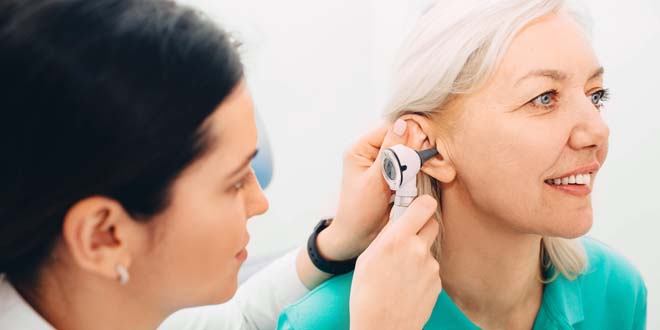
What is hearing loss?
Hearing loss is defined as the reduced ability to hear sounds. It can occur at any age and can happen gradually or very suddenly. The symptoms of hearing loss may be mild, moderate or severe. Depending on the hearing loss cause, hearing loss may be temporary or permanent. Read on to learn about the types of hearing loss and how they are diagnosed.
What causes hearing loss?
Hearing loss can have many causes. The part of the ear involved determines the type and cause of hearing loss.
In adults, the most common causes of hearing loss are:
- Noise: noise-induced hearing loss can happen slowly over time. Being exposed to everyday noises, such as listening to very loud music or using a lawn mower, can damage the structures of the inner ear over many years, leading to hearing loss. Sudden, loud noises, such as an explosion, can also damage your hearing.
- Age: in age-related hearing loss, changes in the inner ear that happen as you get older cause a slow but steady hearing loss. The loss may be mild or severe, but it is always permanent.
Other causes of hearing loss include:
- Earwax buildup
- An object lodged in the ear
- Injury to the ear or head
- An ear infection
- A ruptured eardrum
- Nerve damage due to a medication condition, for example, diabetes
How is hearing loss diagnosed?
A hearing care professional is best equipped to test your hearing and determine if you have hearing loss. You can make an appointment directly with a hearing care professional at a clinic in your area; you do not need a referral from your primary healthcare team. A hearing care professional can do a number of tests and examinations to diagnose hearing loss, including:
- Asking about your current symptoms and your overall health history.
- Doing a physical examination of your ear with an instrument called an otoscope, which provides a clear view of the ear canal and the eardrum.
- Conducting an audiometer test. This test is usually done by an experienced hearing care professional in a sound-proof booth during which you wear headphones and listen to sounds and words directed to each ear. This approach tests for loudness (decibels) and pitch (frequencies) in each ear.
- Evaluating the middle ear. A device called a tympanometer sends a puff of air and sound to the eardrum, which measures how well the eardrum moves. To do this, a small soft rubber tip is inserted into your ear canal, and in just a few seconds the device will generate a result. If the results are normal, the hearing professional will then proceed to complete the hearing test.
- Performing a pure-tone air-conduction and bone-conduction test. After seating you in a soundproof booth, the hearing care professional will either insert foam earphone tips or place headphones on your ears from which you will hear a series of beeps or tones. You’ll be asked to press a button or raise your hand to indicate the softest tone you can hear. These tones will change in pitch (frequency) to give the hearing care professional a full spectrum of what you hear. Some of the tones will sound like a low bass note, while others will sound like a high-pitched note.
- Finally, your hearing care professional will do a speech test by asking you to repeat a list of words given at different volumes. Speech testing helps identify how well you understand the words you are hearing.
The results of all of these tests will then be recorded on a graph called an audiogram, to show whether you have hearing loss. The entire testing process takes approximately 35 to 40 minutes. Once all the tests are complete, your hearing care professional will review the results with you same day, answer any questions you may have and work with you to determine your best treatment options.
What to do if hearing loss is suspected?
If you think you may have a hearing loss, make an appointment at a hearing clinic to have your hearing tested by a hearing care professional. They will ask about your medical history and do a thorough examination of your hearing by performing a number of hearing tests. These tests are simple and non-invasive and will determine whether you have hearing loss, and what type you have.
Most types of hearing loss (age related, noise related or medically related) can be treated with assistive hearing devices or hearing aids.
In other types of hearing loss, the problem that caused the hearing loss is addressed directly, for example, removing a buildup of earwax or taking medication if you have hearing loss due to an ear infection.



